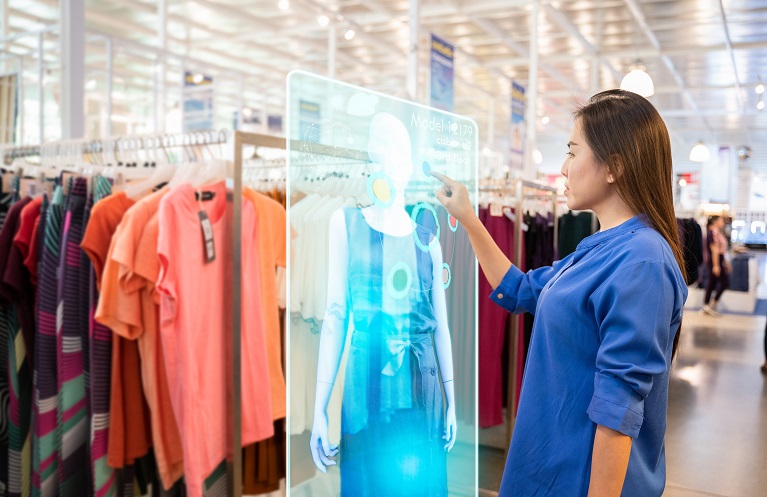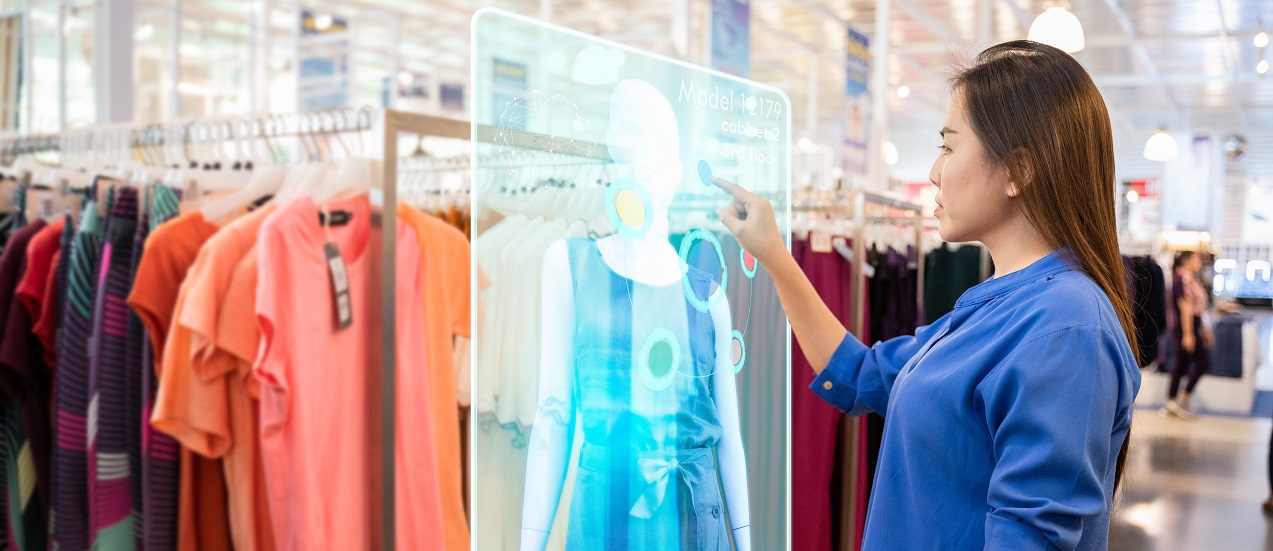With future prospective, retailers are re-imagining stores for the digital age – using technology to make new experiences, from product discovery to checkout
Digital, not physical? Digital and Physical harmoniously ‘go together’.
Times are tough in brick-and-mortar retail. We have all heard about physical storefronts fading out. The COVID-19 pandemic and the ensuing “New Normal” way of life have accentuated the shift towards a more digital world, that has provided further impetus to e-commerce. NRF (National Retail Federation) has predicted that online sales will surpass store sales in near future.
Does that mean the decline of retail brick-and-mortar stores?
No! On the contrary, the increase in the eCommerce revenue has not yet replaced the lost brick-and-mortar revenue. People still miss the gratification and the sensory aspects of an in-person shopping experience.
“As the world becomes a more digital place, we cannot forget about the human connection” - Maulick Pancholi
Physical stores are not just about shopping anymore – they’re more about invoking an immersive in-person experience with human connection, having emotions associated with it which is difficult to replicate in a digital world. Sure, the digital world is conveniently offering round-the-clock service, creating conversational content, and imitating real-world images but it still isn’t equivalent to being physically present in a different environment. Therefore, while the reality of the brick-and-mortar experience has changed, it has not exactly disappeared altogether.
In the face of this duality, digital and physical convergence is inherent
To bridge the gap, a concept is emerging to bring the best of e-commerce and brick-and-mortar retail together: phygital. An optimized phygital marketing strategy and solution prioritizes sensory experiences.
“Phygital” - An amalgamation of physical and digital
What?
Phygital is about enhancing the physical experience by augmenting it with digital. It emphasizes on an omnichannel focus and distinguishes itself from other marketing tactics.
Why?
We often prefer to explore products online but make the final purchase with a real-time experience at the store or vice versa. Seamless, personalized experience and interpersonal interactions are key constituents for customers.
In today’s times when e-commerce is growing rapidly, online-to-offline (O2O) and unified commerce experience is the key to harmonizing the best parts of in-store shopping with the speed and convenience of online shopping.
As per IAB Spain’s annual e-Commerce Study 2020, 72% of Internet users shop online. Therefore, the key lies in bringing online and offline sales together, since:
- 52% of respondents buy in both channels, and it is predicted that 78% of them will continue this buying behavior.
- While 13% will buy from physical shops only, 9% will buy online.
How?
Phygital incorporates digital technology to connect physical assets, people, and the environment. This generates data that can provide insights to optimize and monitor the physical world and superimpose it to the digital world. This inter-disciplinary connection is intrinsic to new technology innovation. For example, IoT uses sensors and analysis to generate data about anything in the physical world while AR augments digital graphics onto the physical world and enhances each other. It focuses on the intersection of “three I’s”: immediacy, immersion, and interaction through connected devices, systems, and data.
The possible avenues that are aided by technologies, include: %20(1).jpg?width=763&name=IMG01%20(4)%20(1).jpg)
Where?
This phenomenon is making the rounds in various aspects of retailing/online:.jpg?width=750&name=IMG02%20(1).jpg)
In-store experience
- In-store seamless checkout
An effortless/contactless in-store shopping experience solution – Using software that automatically identifies the shop as a shopper walks into the store with instant login via digital signage. The shopper can scan products, make a contactless payment, and walk out hassle-free, with anti-theft integrated technology. - Location-based push notifications
This feature allows sending targeted messages to customers within a certain geographic location in a store via Beacon, etc. For example, if customers have a mobile app installed and they are walking past a shop, they could receive a notification from the shop, offering them a discount or a gift with their purchase. - Try IT ON
Some stores offer VR and AR tools in person for try on. For example, Smart Mirror allows customers to access history, check store inventory, and try on items virtually. It provides a streamlined and omnichannel retail experience to the shopper. Cosmetic shops, for example, offer AR try-on feature in-store by using virtual “mirrors”. - In-store robots
Robots can help in managing store inventory and in assisting users with locating products. In huge stores, it is difficult to find not just the product, but even the aisle in the first place. Store service bots can greet customers and help them locate where to go for what they need.
Omnichannel fulfilment
- Dark store strategy
Dark stores are regular retail stores that have been converted to local fulfilment centres. Given the pandemic situation, the number of customers inside physical stores is not high; some brands are strategically closing their doors to customers and turning these into dark stores to fulfil delivery and pickup orders. - Contactless collection: Curb-side or store pickup/returns optimization
This is a solution where customer can initiate collection and book return slots via various mobile technologies. The in-store workers are directly plugged into the collection process with market-leading virtual queuing software that enables customers to notify when they arrive at the curb- side and to receive updates while their order is prepared for collection. - Logistics management
Scanners based on IOT monitor the picking and packing activities of the staff in the warehouse, help in checking the accuracy digitally, and track the movement of goods.
Store operations transformation
- Store associate enablement
Retailers are utilizing messaging apps like WhatsApp for sales and services. What happens here is that customers can message stores by clicking on a website link or social media post or in-store mobile app. Irrespective of where they initiate the conversation, this messaging offers consumers a more convenient way to communicate with the stores. Further, it adds more value to a business in a way that phone calls and email simply cannot. - Point of sale modernization
What if the POS system at your retail store could ring out orders, monitors inventory, expedite payments, create powerful reporting, contribute to efficient customer management, and help your business grow?! Thanks to the modernization of POS systems (POS stored in the cloud, accessed via mobile or tablets or desktop) along with other advanced features (like enabling payment using mobile such as tap and pay via mobile), one can pay with NFC-enabled (Near Field Communication) mobile by using Google Wallet, Apple Pay, etc. - Enable personalization of in-store touchpoints
Store associates have access to offline and online customer data (e.g., data on purchase behavior across channels). By analyzing this data, customer interactions can be tailored to create a unique in-person experience.
Phygital marketing strategies
It is about enticing a customer to shop by optimizing digital and physical marketing tactics. Often, these result in immersive real-time experiences that offer immediate transactions and/or engagement.
- Pop-up stores
If you run an online business, the ability to create a flash interim store is just another way of amplifying a physical experience to your product offerings. - In-store experiences that channelize online ordering and vice versa
If users are using a mobile app to research products, they can check the item stock in a nearby store and reserve it for in-store pickup. If they are in the store, the product’s QR code can be scanned using the in-store app to add it to their Wishlist to purchase later. - Adding QR codes in a hardcopy magazine, in newspaper ads, or in the store
Potential consumers scan the code, which redirects them to the digital location to either make a purchase or get detailed product information, etc. - Automatic product campaigns
In-store purchase data can be stored digitally to re-target automatic campaigns, based on history and patterns or vice versa. - Video shopping
This feature allows customers to text chat and video call with their favorite stores. The purpose is to elevate e-commerce sales and convert website visitors into store customers, the way brands like Nike, Levi’s, and other retailers have done. - Social media
Sentiment analysis on social media posts: Offering a special deal on an ad campaign is an excellent way to gauge customers’ feelings, engage with them directly, and assist them in making actionable in-store purchase decisions. It can also lead to post online and purchase later in the store. Rewarding those customers who engage with your brand on social media is also a way of connecting digitally.
Digital shelf strategy
A digital shelf is an online equivalent of how and where a product is placed in a brick-and-mortar store.
It is where brands can control the story of their products online. It includes everything - search results, search engines, product pages, etc. to your website where content is at the heart of it. Today, consumers are turning to the digital shelf to discover and research products before buying them at the store. Whatever the channel is, shoppers want to create their personalized, digitally-influenced journey.
Here are some excellent real-life examples on the importance of connecting customer experiences across the entire retail ecosystem:
- Amazon Go strategy: Create a touchless experience of letting customers purchase from their mobiles or taking what they would like and automatically charging them after they exit by using AICV (AI computer vision) technology.
- Scan and Go (Decathlon & other retailers): Customers walk into a store, scan products on the shelves with the retailer’s mobile app, pack the products themselves, and then pay electronically via contactless payment options.
- Kentucky Fried Chicken: The fast-food chain uses facial recognition and AI technology to cater to diners’ personalized offers and ordering.
- IKEA: This Swedish multinational conglomerate offers furniture, appliances, home accessories, etc. IKEA has launched an augmented reality (AR) app for customers to visualize how items would look inside their homes.
- Timberland Virtual Fitting Room: The fashion company has installed magic mirrors to provide the virtual try-on feature, delivering an omnichannel experience for the digital shopper.
- Whole Foods (Dark stores): Whole Foods recently converted stores in Los Angeles and New York into dark stores.
- Reformation brick-and-mortar: Experience stores where the shopper can touch and feel the quality of the goods, but perhaps not buy right away. Touch screens have been installed to allow customers to pick and choose the products they want to try on, which mirrors the customers’ online journey.
- Marketing Strategy:
- Pop-up stores or event booths: The Sonos audio company has set up a pop-up store and has designed isolated sound chambers to provide an exciting 3D soundscape experience. By using a preloaded iPad, patrons can personalize their experience. This further helps the company understand its audience by analyzing the data gathered from the app.
- Coca-Cola organized a phygital marketing campaign called “Scratch & win”.
Our presence: IoT BoxX (Nagarro Allgeier ES)
Our IoT BoxX is fully integrated with SAP and demonstrates our take on Amazon’s GO concept. We focus on a simple way to choose and buy products without the hassle of going via the checkout.
This pop-up store leverages the expertise of Nagarro ES and uses the experience of the retail industry in a highly compact format to come up with an approach that anticipates what shopping experiences might look like in the future.
The IoT BoxX not only puts forth solution strategies that are already feasible today but it also models an approach that will probably be market-ready in the future too.
End-to-end uses cases are:
- Future store concept: All new technologies, voice interaction, computer vision, robots, beacons, digital signage are integrated to provide an end-to-end, seamless in-store shopping experience.
- Go concept store: Real size pop-up store shows how an omnichannel store will look like in the future.
- Autonomous micro-market: This provides a smart shopping on-the-go anything, anywhere, anytime experience to the customer.
- Knowledge-4 retail: An innovation platform that links the analogous retail world with the digital retail world using artificial intelligence.
- SES Vusion integration Suite: It helps the retailer to integrate electronic shelf labels in retail customer experience and in their retail processes.
Final thoughts
Brick-and-mortar stores are struggling because buying a variety of products online is a convenient option for many. Despite that, many digital retailers are racing to gain the one advantage they can never replicate online: stores.
Be it through pop-up stores or by investing in retail outlets or by offering concessions, digital retailers are craving to capture the magic of face-to-face shopping experiences.
Amazon and Alibaba, the world’s largest online retailers, identify this cohesive model, known as New Retail in China, as being the most successful.
In conclusion, the dynamic between physical and online shopping experience has shifted. Current shopping trends demand “Experiential Retailtainment” - connected, unique, interactive, fun-loving experiences where physical and digital go hand-in-hand. It is no longer about the “digital experience” only. Instead, it is all about “customer expectation and experience”, which ought to be the objective of a successful strategy to boost loyalty and sales.
The future is now. It is the time for retailers to put the pedal to the metal and unlock the value of physical-digital convergence.
Do you want to make the physical retail world experiential, safer, and sustainable? Think you could do with some help on how and where to begin? Explore our offerings and get in touch with us today!





